The Role of Lady of Guadalupe in Gender and Religions in Mexico
VerifiedAdded on 2023/01/09
|11
|3005
|89
Essay
AI Summary
This essay delves into the multifaceted role of the Lady of Guadalupe in Mexican history and culture. It examines her significance as a powerful female icon, exploring her religious connotations and national influence, including her connection to the Virgin Mary. The essay highlights her importance in the empowerment of Mexican-American women within a patriarchal society and her role as a symbol of unity and social justice. It discusses her impact on political movements, her influence on gender roles, and her enduring presence as a cultural and religious symbol, providing a comprehensive analysis of her legacy and continued relevance. The essay also explores controversies and interpretations, emphasizing her enduring impact on the lives of Mexican people and her role as a source of inspiration and empowerment.
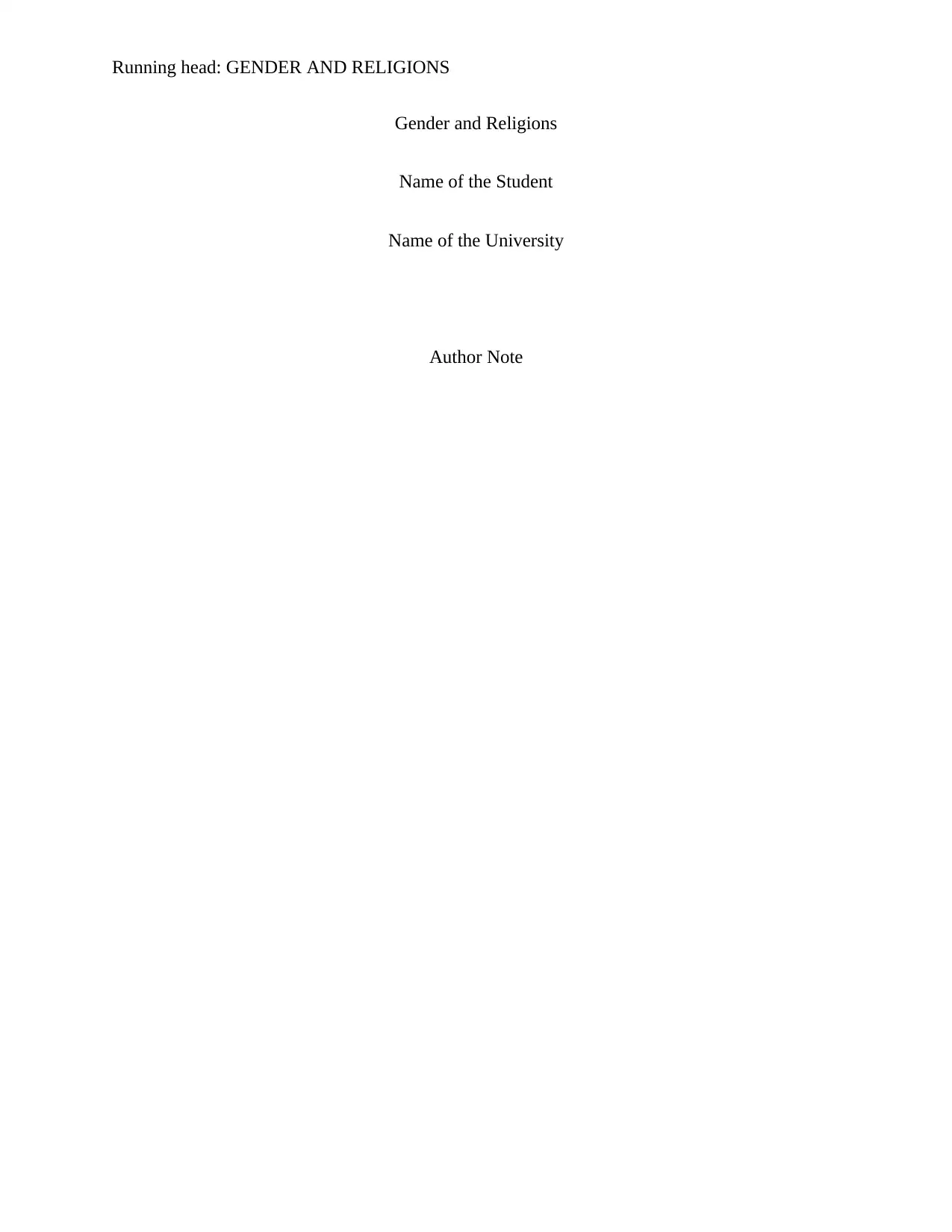
Running head: GENDER AND RELIGIONS
Gender and Religions
Name of the Student
Name of the University
Author Note
Gender and Religions
Name of the Student
Name of the University
Author Note
Paraphrase This Document
Need a fresh take? Get an instant paraphrase of this document with our AI Paraphraser
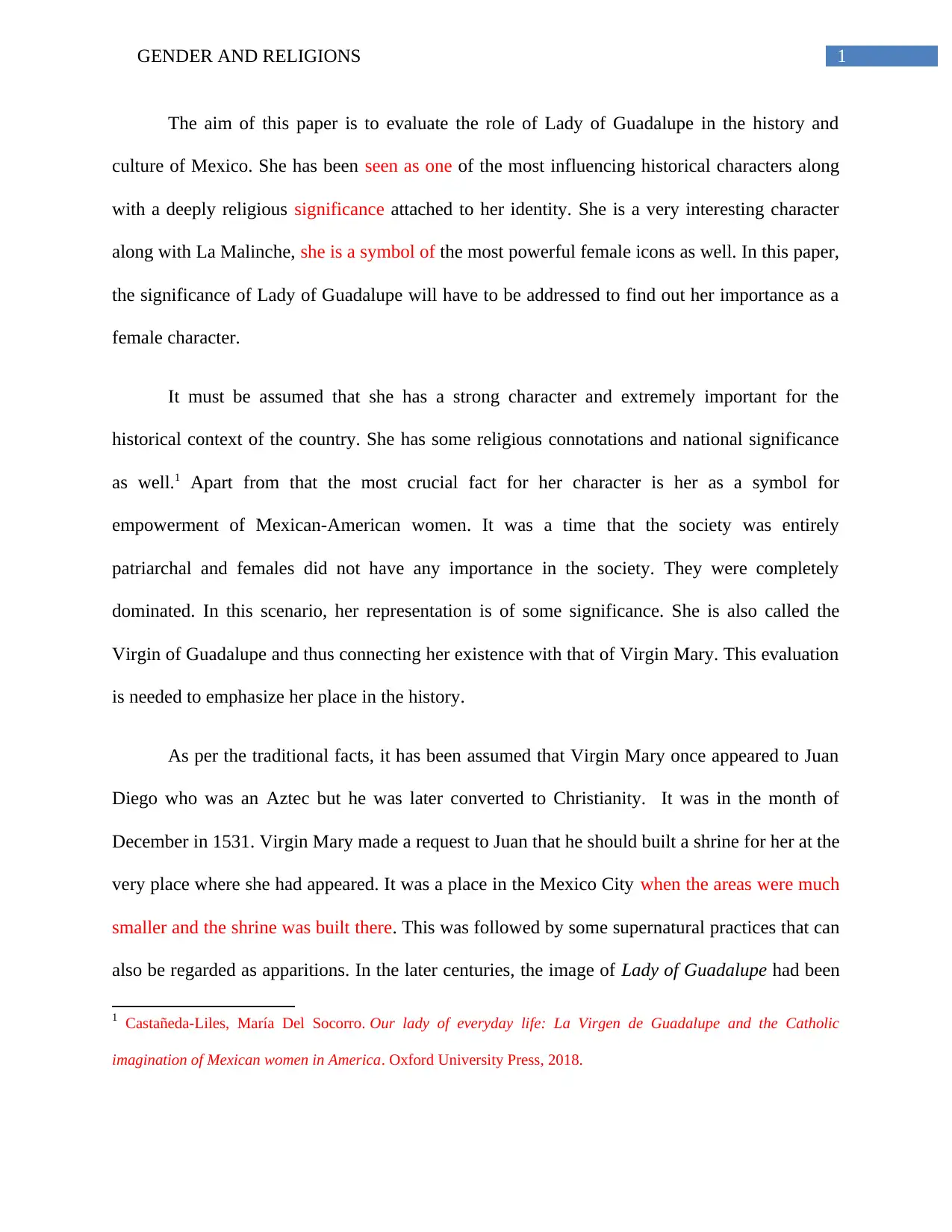
1GENDER AND RELIGIONS
The aim of this paper is to evaluate the role of Lady of Guadalupe in the history and
culture of Mexico. She has been seen as one of the most influencing historical characters along
with a deeply religious significance attached to her identity. She is a very interesting character
along with La Malinche, she is a symbol of the most powerful female icons as well. In this paper,
the significance of Lady of Guadalupe will have to be addressed to find out her importance as a
female character.
It must be assumed that she has a strong character and extremely important for the
historical context of the country. She has some religious connotations and national significance
as well.1 Apart from that the most crucial fact for her character is her as a symbol for
empowerment of Mexican-American women. It was a time that the society was entirely
patriarchal and females did not have any importance in the society. They were completely
dominated. In this scenario, her representation is of some significance. She is also called the
Virgin of Guadalupe and thus connecting her existence with that of Virgin Mary. This evaluation
is needed to emphasize her place in the history.
As per the traditional facts, it has been assumed that Virgin Mary once appeared to Juan
Diego who was an Aztec but he was later converted to Christianity. It was in the month of
December in 1531. Virgin Mary made a request to Juan that he should built a shrine for her at the
very place where she had appeared. It was a place in the Mexico City when the areas were much
smaller and the shrine was built there. This was followed by some supernatural practices that can
also be regarded as apparitions. In the later centuries, the image of Lady of Guadalupe had been
1 Castañeda-Liles, María Del Socorro. Our lady of everyday life: La Virgen de Guadalupe and the Catholic
imagination of Mexican women in America. Oxford University Press, 2018.
The aim of this paper is to evaluate the role of Lady of Guadalupe in the history and
culture of Mexico. She has been seen as one of the most influencing historical characters along
with a deeply religious significance attached to her identity. She is a very interesting character
along with La Malinche, she is a symbol of the most powerful female icons as well. In this paper,
the significance of Lady of Guadalupe will have to be addressed to find out her importance as a
female character.
It must be assumed that she has a strong character and extremely important for the
historical context of the country. She has some religious connotations and national significance
as well.1 Apart from that the most crucial fact for her character is her as a symbol for
empowerment of Mexican-American women. It was a time that the society was entirely
patriarchal and females did not have any importance in the society. They were completely
dominated. In this scenario, her representation is of some significance. She is also called the
Virgin of Guadalupe and thus connecting her existence with that of Virgin Mary. This evaluation
is needed to emphasize her place in the history.
As per the traditional facts, it has been assumed that Virgin Mary once appeared to Juan
Diego who was an Aztec but he was later converted to Christianity. It was in the month of
December in 1531. Virgin Mary made a request to Juan that he should built a shrine for her at the
very place where she had appeared. It was a place in the Mexico City when the areas were much
smaller and the shrine was built there. This was followed by some supernatural practices that can
also be regarded as apparitions. In the later centuries, the image of Lady of Guadalupe had been
1 Castañeda-Liles, María Del Socorro. Our lady of everyday life: La Virgen de Guadalupe and the Catholic
imagination of Mexican women in America. Oxford University Press, 2018.
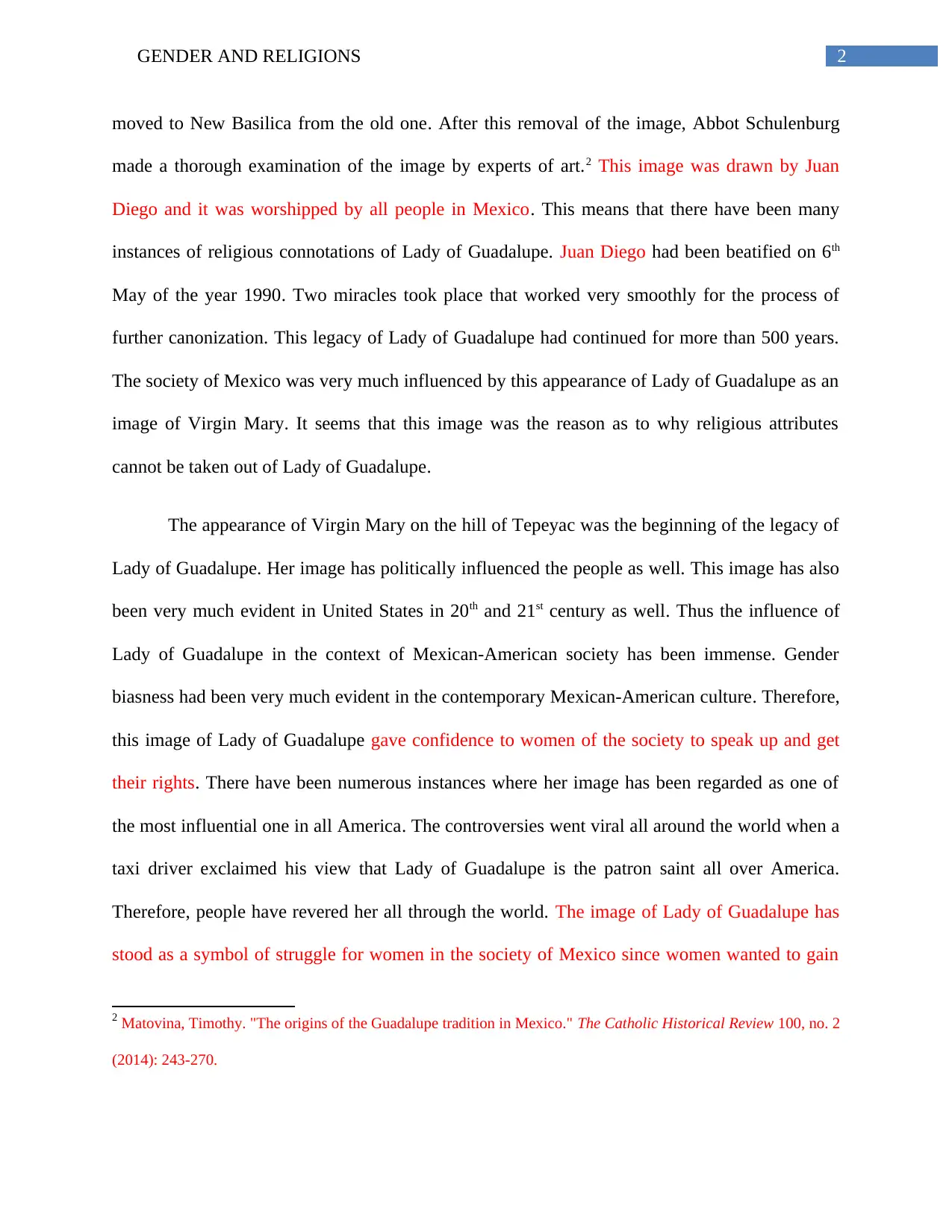
2GENDER AND RELIGIONS
moved to New Basilica from the old one. After this removal of the image, Abbot Schulenburg
made a thorough examination of the image by experts of art.2 This image was drawn by Juan
Diego and it was worshipped by all people in Mexico. This means that there have been many
instances of religious connotations of Lady of Guadalupe. Juan Diego had been beatified on 6th
May of the year 1990. Two miracles took place that worked very smoothly for the process of
further canonization. This legacy of Lady of Guadalupe had continued for more than 500 years.
The society of Mexico was very much influenced by this appearance of Lady of Guadalupe as an
image of Virgin Mary. It seems that this image was the reason as to why religious attributes
cannot be taken out of Lady of Guadalupe.
The appearance of Virgin Mary on the hill of Tepeyac was the beginning of the legacy of
Lady of Guadalupe. Her image has politically influenced the people as well. This image has also
been very much evident in United States in 20th and 21st century as well. Thus the influence of
Lady of Guadalupe in the context of Mexican-American society has been immense. Gender
biasness had been very much evident in the contemporary Mexican-American culture. Therefore,
this image of Lady of Guadalupe gave confidence to women of the society to speak up and get
their rights. There have been numerous instances where her image has been regarded as one of
the most influential one in all America. The controversies went viral all around the world when a
taxi driver exclaimed his view that Lady of Guadalupe is the patron saint all over America.
Therefore, people have revered her all through the world. The image of Lady of Guadalupe has
stood as a symbol of struggle for women in the society of Mexico since women wanted to gain
2 Matovina, Timothy. "The origins of the Guadalupe tradition in Mexico." The Catholic Historical Review 100, no. 2
(2014): 243-270.
moved to New Basilica from the old one. After this removal of the image, Abbot Schulenburg
made a thorough examination of the image by experts of art.2 This image was drawn by Juan
Diego and it was worshipped by all people in Mexico. This means that there have been many
instances of religious connotations of Lady of Guadalupe. Juan Diego had been beatified on 6th
May of the year 1990. Two miracles took place that worked very smoothly for the process of
further canonization. This legacy of Lady of Guadalupe had continued for more than 500 years.
The society of Mexico was very much influenced by this appearance of Lady of Guadalupe as an
image of Virgin Mary. It seems that this image was the reason as to why religious attributes
cannot be taken out of Lady of Guadalupe.
The appearance of Virgin Mary on the hill of Tepeyac was the beginning of the legacy of
Lady of Guadalupe. Her image has politically influenced the people as well. This image has also
been very much evident in United States in 20th and 21st century as well. Thus the influence of
Lady of Guadalupe in the context of Mexican-American society has been immense. Gender
biasness had been very much evident in the contemporary Mexican-American culture. Therefore,
this image of Lady of Guadalupe gave confidence to women of the society to speak up and get
their rights. There have been numerous instances where her image has been regarded as one of
the most influential one in all America. The controversies went viral all around the world when a
taxi driver exclaimed his view that Lady of Guadalupe is the patron saint all over America.
Therefore, people have revered her all through the world. The image of Lady of Guadalupe has
stood as a symbol of struggle for women in the society of Mexico since women wanted to gain
2 Matovina, Timothy. "The origins of the Guadalupe tradition in Mexico." The Catholic Historical Review 100, no. 2
(2014): 243-270.
⊘ This is a preview!⊘
Do you want full access?
Subscribe today to unlock all pages.

Trusted by 1+ million students worldwide
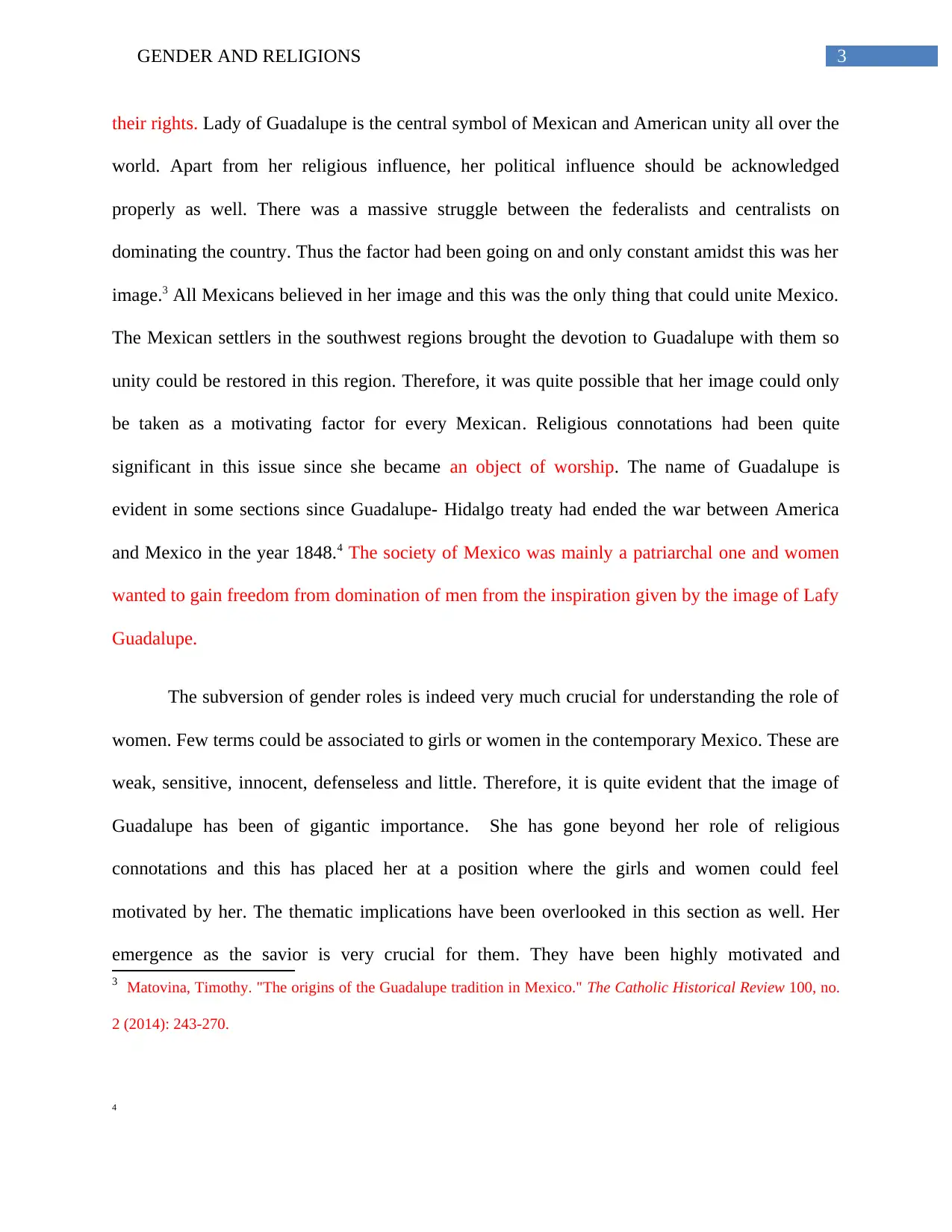
3GENDER AND RELIGIONS
their rights. Lady of Guadalupe is the central symbol of Mexican and American unity all over the
world. Apart from her religious influence, her political influence should be acknowledged
properly as well. There was a massive struggle between the federalists and centralists on
dominating the country. Thus the factor had been going on and only constant amidst this was her
image.3 All Mexicans believed in her image and this was the only thing that could unite Mexico.
The Mexican settlers in the southwest regions brought the devotion to Guadalupe with them so
unity could be restored in this region. Therefore, it was quite possible that her image could only
be taken as a motivating factor for every Mexican. Religious connotations had been quite
significant in this issue since she became an object of worship. The name of Guadalupe is
evident in some sections since Guadalupe- Hidalgo treaty had ended the war between America
and Mexico in the year 1848.4 The society of Mexico was mainly a patriarchal one and women
wanted to gain freedom from domination of men from the inspiration given by the image of Lafy
Guadalupe.
The subversion of gender roles is indeed very much crucial for understanding the role of
women. Few terms could be associated to girls or women in the contemporary Mexico. These are
weak, sensitive, innocent, defenseless and little. Therefore, it is quite evident that the image of
Guadalupe has been of gigantic importance. She has gone beyond her role of religious
connotations and this has placed her at a position where the girls and women could feel
motivated by her. The thematic implications have been overlooked in this section as well. Her
emergence as the savior is very crucial for them. They have been highly motivated and
3 Matovina, Timothy. "The origins of the Guadalupe tradition in Mexico." The Catholic Historical Review 100, no.
2 (2014): 243-270.
4
their rights. Lady of Guadalupe is the central symbol of Mexican and American unity all over the
world. Apart from her religious influence, her political influence should be acknowledged
properly as well. There was a massive struggle between the federalists and centralists on
dominating the country. Thus the factor had been going on and only constant amidst this was her
image.3 All Mexicans believed in her image and this was the only thing that could unite Mexico.
The Mexican settlers in the southwest regions brought the devotion to Guadalupe with them so
unity could be restored in this region. Therefore, it was quite possible that her image could only
be taken as a motivating factor for every Mexican. Religious connotations had been quite
significant in this issue since she became an object of worship. The name of Guadalupe is
evident in some sections since Guadalupe- Hidalgo treaty had ended the war between America
and Mexico in the year 1848.4 The society of Mexico was mainly a patriarchal one and women
wanted to gain freedom from domination of men from the inspiration given by the image of Lafy
Guadalupe.
The subversion of gender roles is indeed very much crucial for understanding the role of
women. Few terms could be associated to girls or women in the contemporary Mexico. These are
weak, sensitive, innocent, defenseless and little. Therefore, it is quite evident that the image of
Guadalupe has been of gigantic importance. She has gone beyond her role of religious
connotations and this has placed her at a position where the girls and women could feel
motivated by her. The thematic implications have been overlooked in this section as well. Her
emergence as the savior is very crucial for them. They have been highly motivated and
3 Matovina, Timothy. "The origins of the Guadalupe tradition in Mexico." The Catholic Historical Review 100, no.
2 (2014): 243-270.
4
Paraphrase This Document
Need a fresh take? Get an instant paraphrase of this document with our AI Paraphraser
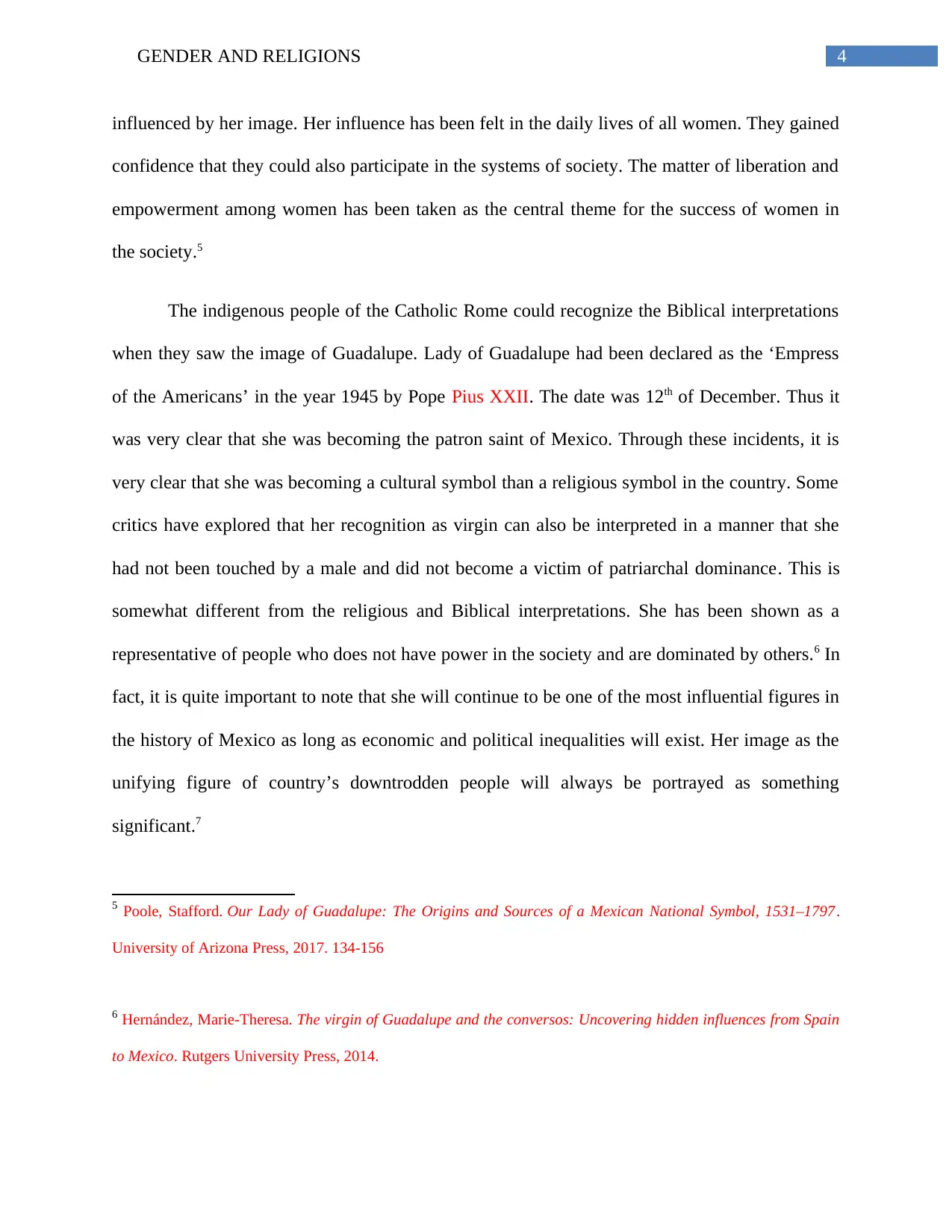
4GENDER AND RELIGIONS
influenced by her image. Her influence has been felt in the daily lives of all women. They gained
confidence that they could also participate in the systems of society. The matter of liberation and
empowerment among women has been taken as the central theme for the success of women in
the society.5
The indigenous people of the Catholic Rome could recognize the Biblical interpretations
when they saw the image of Guadalupe. Lady of Guadalupe had been declared as the ‘Empress
of the Americans’ in the year 1945 by Pope Pius XXII. The date was 12th of December. Thus it
was very clear that she was becoming the patron saint of Mexico. Through these incidents, it is
very clear that she was becoming a cultural symbol than a religious symbol in the country. Some
critics have explored that her recognition as virgin can also be interpreted in a manner that she
had not been touched by a male and did not become a victim of patriarchal dominance. This is
somewhat different from the religious and Biblical interpretations. She has been shown as a
representative of people who does not have power in the society and are dominated by others.6 In
fact, it is quite important to note that she will continue to be one of the most influential figures in
the history of Mexico as long as economic and political inequalities will exist. Her image as the
unifying figure of country’s downtrodden people will always be portrayed as something
significant.7
5 Poole, Stafford. Our Lady of Guadalupe: The Origins and Sources of a Mexican National Symbol, 1531–1797.
University of Arizona Press, 2017. 134-156
6 Hernández, Marie-Theresa. The virgin of Guadalupe and the conversos: Uncovering hidden influences from Spain
to Mexico. Rutgers University Press, 2014.
influenced by her image. Her influence has been felt in the daily lives of all women. They gained
confidence that they could also participate in the systems of society. The matter of liberation and
empowerment among women has been taken as the central theme for the success of women in
the society.5
The indigenous people of the Catholic Rome could recognize the Biblical interpretations
when they saw the image of Guadalupe. Lady of Guadalupe had been declared as the ‘Empress
of the Americans’ in the year 1945 by Pope Pius XXII. The date was 12th of December. Thus it
was very clear that she was becoming the patron saint of Mexico. Through these incidents, it is
very clear that she was becoming a cultural symbol than a religious symbol in the country. Some
critics have explored that her recognition as virgin can also be interpreted in a manner that she
had not been touched by a male and did not become a victim of patriarchal dominance. This is
somewhat different from the religious and Biblical interpretations. She has been shown as a
representative of people who does not have power in the society and are dominated by others.6 In
fact, it is quite important to note that she will continue to be one of the most influential figures in
the history of Mexico as long as economic and political inequalities will exist. Her image as the
unifying figure of country’s downtrodden people will always be portrayed as something
significant.7
5 Poole, Stafford. Our Lady of Guadalupe: The Origins and Sources of a Mexican National Symbol, 1531–1797.
University of Arizona Press, 2017. 134-156
6 Hernández, Marie-Theresa. The virgin of Guadalupe and the conversos: Uncovering hidden influences from Spain
to Mexico. Rutgers University Press, 2014.
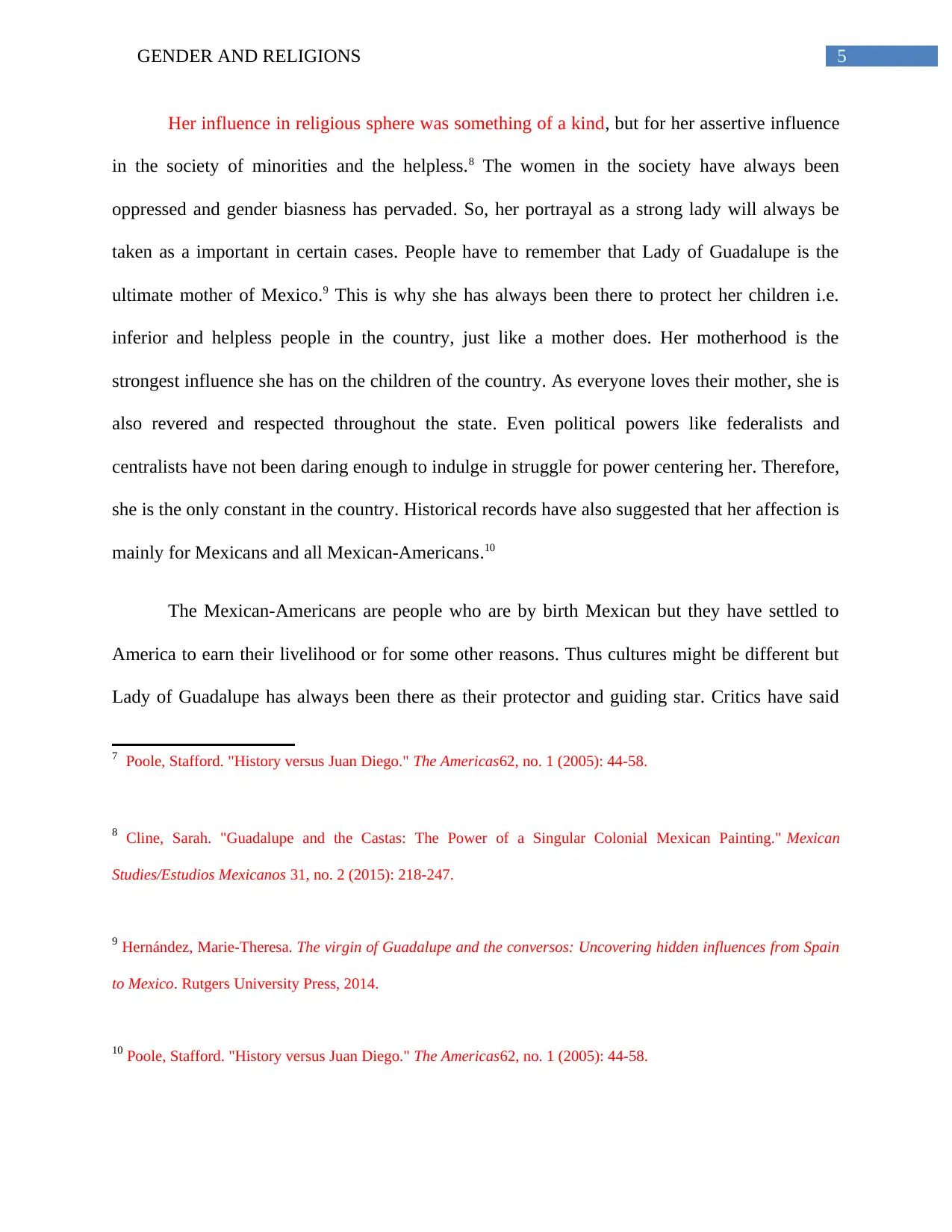
5GENDER AND RELIGIONS
Her influence in religious sphere was something of a kind, but for her assertive influence
in the society of minorities and the helpless.8 The women in the society have always been
oppressed and gender biasness has pervaded. So, her portrayal as a strong lady will always be
taken as a important in certain cases. People have to remember that Lady of Guadalupe is the
ultimate mother of Mexico.9 This is why she has always been there to protect her children i.e.
inferior and helpless people in the country, just like a mother does. Her motherhood is the
strongest influence she has on the children of the country. As everyone loves their mother, she is
also revered and respected throughout the state. Even political powers like federalists and
centralists have not been daring enough to indulge in struggle for power centering her. Therefore,
she is the only constant in the country. Historical records have also suggested that her affection is
mainly for Mexicans and all Mexican-Americans.10
The Mexican-Americans are people who are by birth Mexican but they have settled to
America to earn their livelihood or for some other reasons. Thus cultures might be different but
Lady of Guadalupe has always been there as their protector and guiding star. Critics have said
7 Poole, Stafford. "History versus Juan Diego." The Americas62, no. 1 (2005): 44-58.
8 Cline, Sarah. "Guadalupe and the Castas: The Power of a Singular Colonial Mexican Painting." Mexican
Studies/Estudios Mexicanos 31, no. 2 (2015): 218-247.
9 Hernández, Marie-Theresa. The virgin of Guadalupe and the conversos: Uncovering hidden influences from Spain
to Mexico. Rutgers University Press, 2014.
10 Poole, Stafford. "History versus Juan Diego." The Americas62, no. 1 (2005): 44-58.
Her influence in religious sphere was something of a kind, but for her assertive influence
in the society of minorities and the helpless.8 The women in the society have always been
oppressed and gender biasness has pervaded. So, her portrayal as a strong lady will always be
taken as a important in certain cases. People have to remember that Lady of Guadalupe is the
ultimate mother of Mexico.9 This is why she has always been there to protect her children i.e.
inferior and helpless people in the country, just like a mother does. Her motherhood is the
strongest influence she has on the children of the country. As everyone loves their mother, she is
also revered and respected throughout the state. Even political powers like federalists and
centralists have not been daring enough to indulge in struggle for power centering her. Therefore,
she is the only constant in the country. Historical records have also suggested that her affection is
mainly for Mexicans and all Mexican-Americans.10
The Mexican-Americans are people who are by birth Mexican but they have settled to
America to earn their livelihood or for some other reasons. Thus cultures might be different but
Lady of Guadalupe has always been there as their protector and guiding star. Critics have said
7 Poole, Stafford. "History versus Juan Diego." The Americas62, no. 1 (2005): 44-58.
8 Cline, Sarah. "Guadalupe and the Castas: The Power of a Singular Colonial Mexican Painting." Mexican
Studies/Estudios Mexicanos 31, no. 2 (2015): 218-247.
9 Hernández, Marie-Theresa. The virgin of Guadalupe and the conversos: Uncovering hidden influences from Spain
to Mexico. Rutgers University Press, 2014.
10 Poole, Stafford. "History versus Juan Diego." The Americas62, no. 1 (2005): 44-58.
⊘ This is a preview!⊘
Do you want full access?
Subscribe today to unlock all pages.

Trusted by 1+ million students worldwide
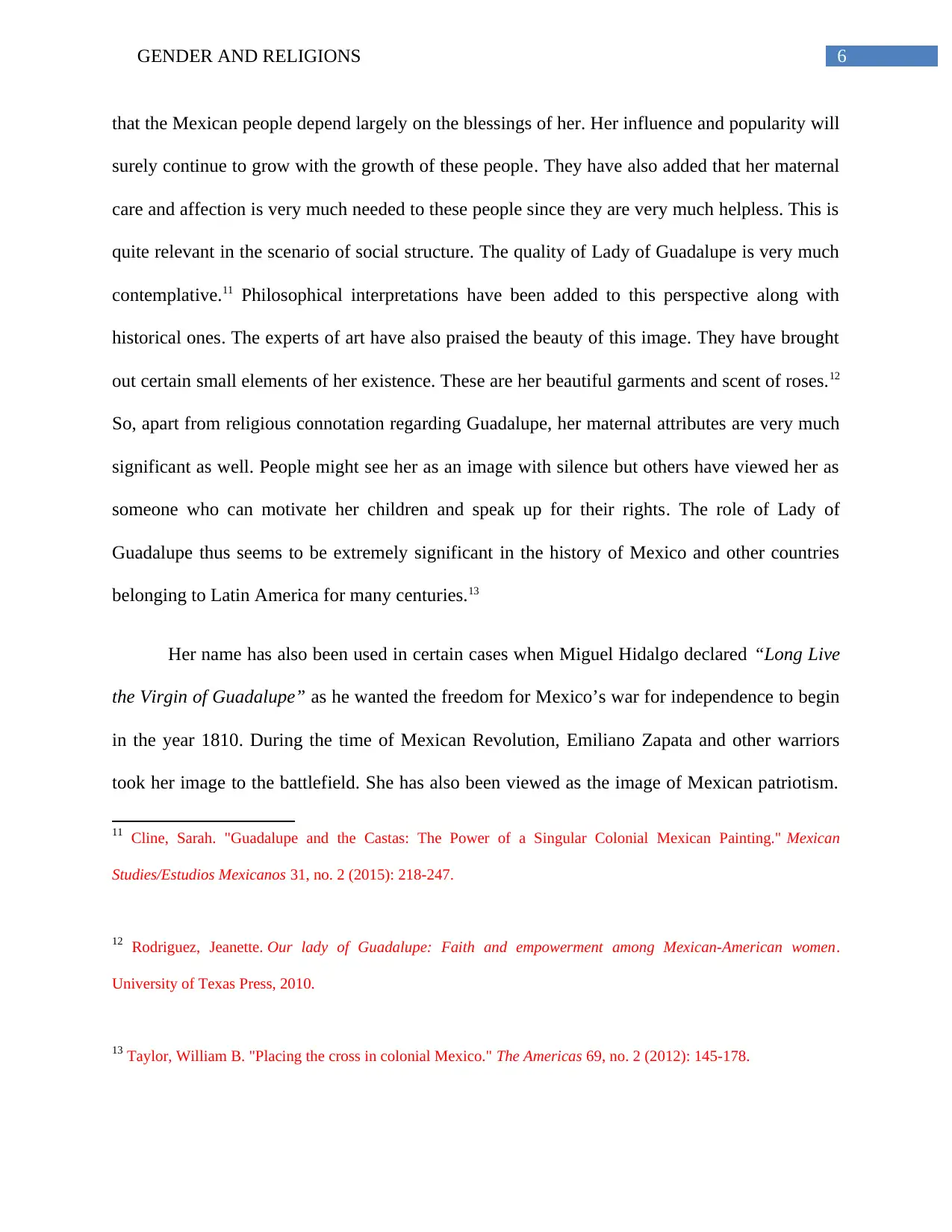
6GENDER AND RELIGIONS
that the Mexican people depend largely on the blessings of her. Her influence and popularity will
surely continue to grow with the growth of these people. They have also added that her maternal
care and affection is very much needed to these people since they are very much helpless. This is
quite relevant in the scenario of social structure. The quality of Lady of Guadalupe is very much
contemplative.11 Philosophical interpretations have been added to this perspective along with
historical ones. The experts of art have also praised the beauty of this image. They have brought
out certain small elements of her existence. These are her beautiful garments and scent of roses.12
So, apart from religious connotation regarding Guadalupe, her maternal attributes are very much
significant as well. People might see her as an image with silence but others have viewed her as
someone who can motivate her children and speak up for their rights. The role of Lady of
Guadalupe thus seems to be extremely significant in the history of Mexico and other countries
belonging to Latin America for many centuries.13
Her name has also been used in certain cases when Miguel Hidalgo declared “Long Live
the Virgin of Guadalupe” as he wanted the freedom for Mexico’s war for independence to begin
in the year 1810. During the time of Mexican Revolution, Emiliano Zapata and other warriors
took her image to the battlefield. She has also been viewed as the image of Mexican patriotism.
11 Cline, Sarah. "Guadalupe and the Castas: The Power of a Singular Colonial Mexican Painting." Mexican
Studies/Estudios Mexicanos 31, no. 2 (2015): 218-247.
12 Rodriguez, Jeanette. Our lady of Guadalupe: Faith and empowerment among Mexican-American women.
University of Texas Press, 2010.
13 Taylor, William B. "Placing the cross in colonial Mexico." The Americas 69, no. 2 (2012): 145-178.
that the Mexican people depend largely on the blessings of her. Her influence and popularity will
surely continue to grow with the growth of these people. They have also added that her maternal
care and affection is very much needed to these people since they are very much helpless. This is
quite relevant in the scenario of social structure. The quality of Lady of Guadalupe is very much
contemplative.11 Philosophical interpretations have been added to this perspective along with
historical ones. The experts of art have also praised the beauty of this image. They have brought
out certain small elements of her existence. These are her beautiful garments and scent of roses.12
So, apart from religious connotation regarding Guadalupe, her maternal attributes are very much
significant as well. People might see her as an image with silence but others have viewed her as
someone who can motivate her children and speak up for their rights. The role of Lady of
Guadalupe thus seems to be extremely significant in the history of Mexico and other countries
belonging to Latin America for many centuries.13
Her name has also been used in certain cases when Miguel Hidalgo declared “Long Live
the Virgin of Guadalupe” as he wanted the freedom for Mexico’s war for independence to begin
in the year 1810. During the time of Mexican Revolution, Emiliano Zapata and other warriors
took her image to the battlefield. She has also been viewed as the image of Mexican patriotism.
11 Cline, Sarah. "Guadalupe and the Castas: The Power of a Singular Colonial Mexican Painting." Mexican
Studies/Estudios Mexicanos 31, no. 2 (2015): 218-247.
12 Rodriguez, Jeanette. Our lady of Guadalupe: Faith and empowerment among Mexican-American women.
University of Texas Press, 2010.
13 Taylor, William B. "Placing the cross in colonial Mexico." The Americas 69, no. 2 (2012): 145-178.
Paraphrase This Document
Need a fresh take? Get an instant paraphrase of this document with our AI Paraphraser
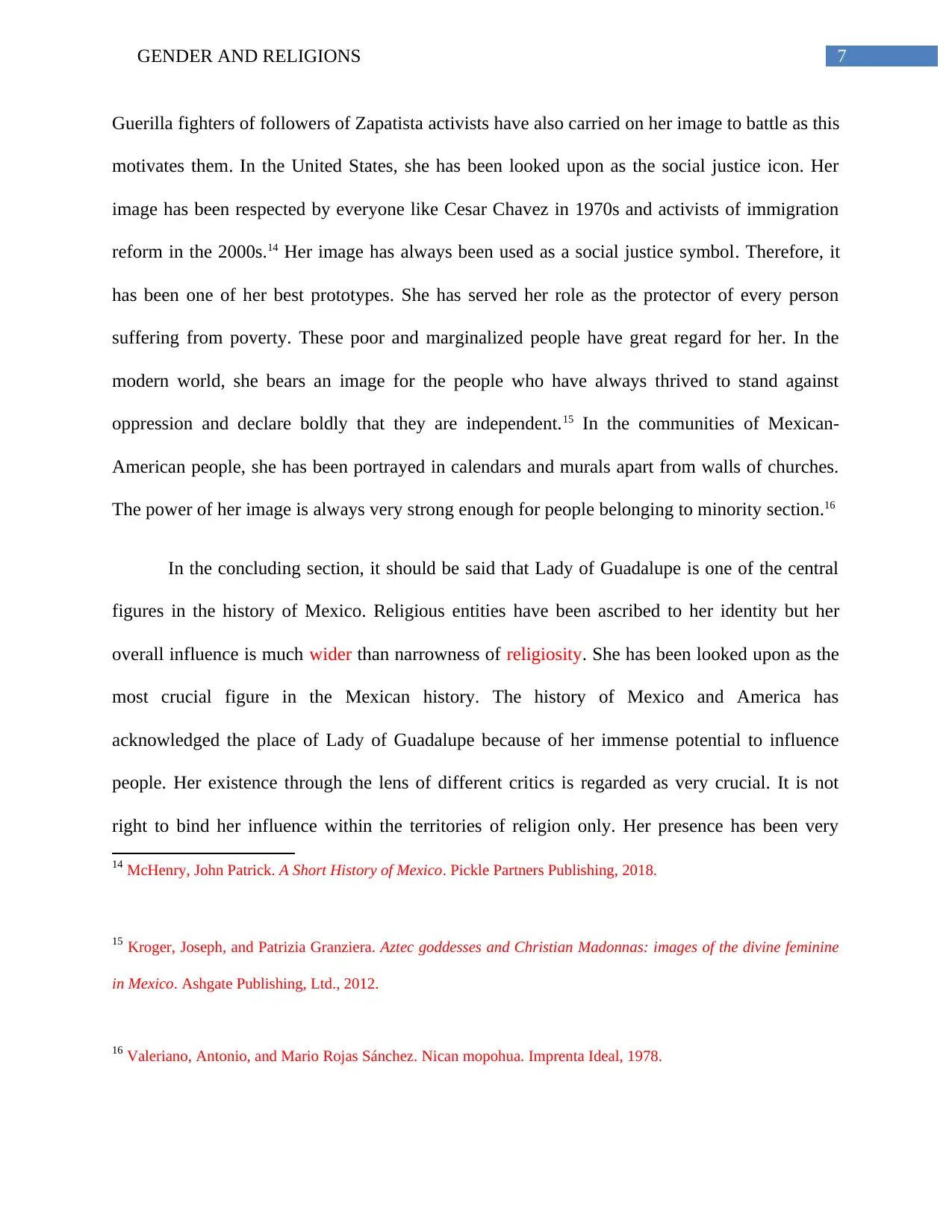
7GENDER AND RELIGIONS
Guerilla fighters of followers of Zapatista activists have also carried on her image to battle as this
motivates them. In the United States, she has been looked upon as the social justice icon. Her
image has been respected by everyone like Cesar Chavez in 1970s and activists of immigration
reform in the 2000s.14 Her image has always been used as a social justice symbol. Therefore, it
has been one of her best prototypes. She has served her role as the protector of every person
suffering from poverty. These poor and marginalized people have great regard for her. In the
modern world, she bears an image for the people who have always thrived to stand against
oppression and declare boldly that they are independent.15 In the communities of Mexican-
American people, she has been portrayed in calendars and murals apart from walls of churches.
The power of her image is always very strong enough for people belonging to minority section.16
In the concluding section, it should be said that Lady of Guadalupe is one of the central
figures in the history of Mexico. Religious entities have been ascribed to her identity but her
overall influence is much wider than narrowness of religiosity. She has been looked upon as the
most crucial figure in the Mexican history. The history of Mexico and America has
acknowledged the place of Lady of Guadalupe because of her immense potential to influence
people. Her existence through the lens of different critics is regarded as very crucial. It is not
right to bind her influence within the territories of religion only. Her presence has been very
14 McHenry, John Patrick. A Short History of Mexico. Pickle Partners Publishing, 2018.
15 Kroger, Joseph, and Patrizia Granziera. Aztec goddesses and Christian Madonnas: images of the divine feminine
in Mexico. Ashgate Publishing, Ltd., 2012.
16 Valeriano, Antonio, and Mario Rojas Sánchez. Nican mopohua. Imprenta Ideal, 1978.
Guerilla fighters of followers of Zapatista activists have also carried on her image to battle as this
motivates them. In the United States, she has been looked upon as the social justice icon. Her
image has been respected by everyone like Cesar Chavez in 1970s and activists of immigration
reform in the 2000s.14 Her image has always been used as a social justice symbol. Therefore, it
has been one of her best prototypes. She has served her role as the protector of every person
suffering from poverty. These poor and marginalized people have great regard for her. In the
modern world, she bears an image for the people who have always thrived to stand against
oppression and declare boldly that they are independent.15 In the communities of Mexican-
American people, she has been portrayed in calendars and murals apart from walls of churches.
The power of her image is always very strong enough for people belonging to minority section.16
In the concluding section, it should be said that Lady of Guadalupe is one of the central
figures in the history of Mexico. Religious entities have been ascribed to her identity but her
overall influence is much wider than narrowness of religiosity. She has been looked upon as the
most crucial figure in the Mexican history. The history of Mexico and America has
acknowledged the place of Lady of Guadalupe because of her immense potential to influence
people. Her existence through the lens of different critics is regarded as very crucial. It is not
right to bind her influence within the territories of religion only. Her presence has been very
14 McHenry, John Patrick. A Short History of Mexico. Pickle Partners Publishing, 2018.
15 Kroger, Joseph, and Patrizia Granziera. Aztec goddesses and Christian Madonnas: images of the divine feminine
in Mexico. Ashgate Publishing, Ltd., 2012.
16 Valeriano, Antonio, and Mario Rojas Sánchez. Nican mopohua. Imprenta Ideal, 1978.

8GENDER AND RELIGIONS
much evident in the history of United States of America as well. Apart from that, the author of
the book has also declared that Mexican-Americans and Latin people will never be knocked
down since they have Lady of Guadalupe. This is how she is the guiding power for all those
people whom she represents. She will protect their existence and their culture.
much evident in the history of United States of America as well. Apart from that, the author of
the book has also declared that Mexican-Americans and Latin people will never be knocked
down since they have Lady of Guadalupe. This is how she is the guiding power for all those
people whom she represents. She will protect their existence and their culture.
⊘ This is a preview!⊘
Do you want full access?
Subscribe today to unlock all pages.

Trusted by 1+ million students worldwide
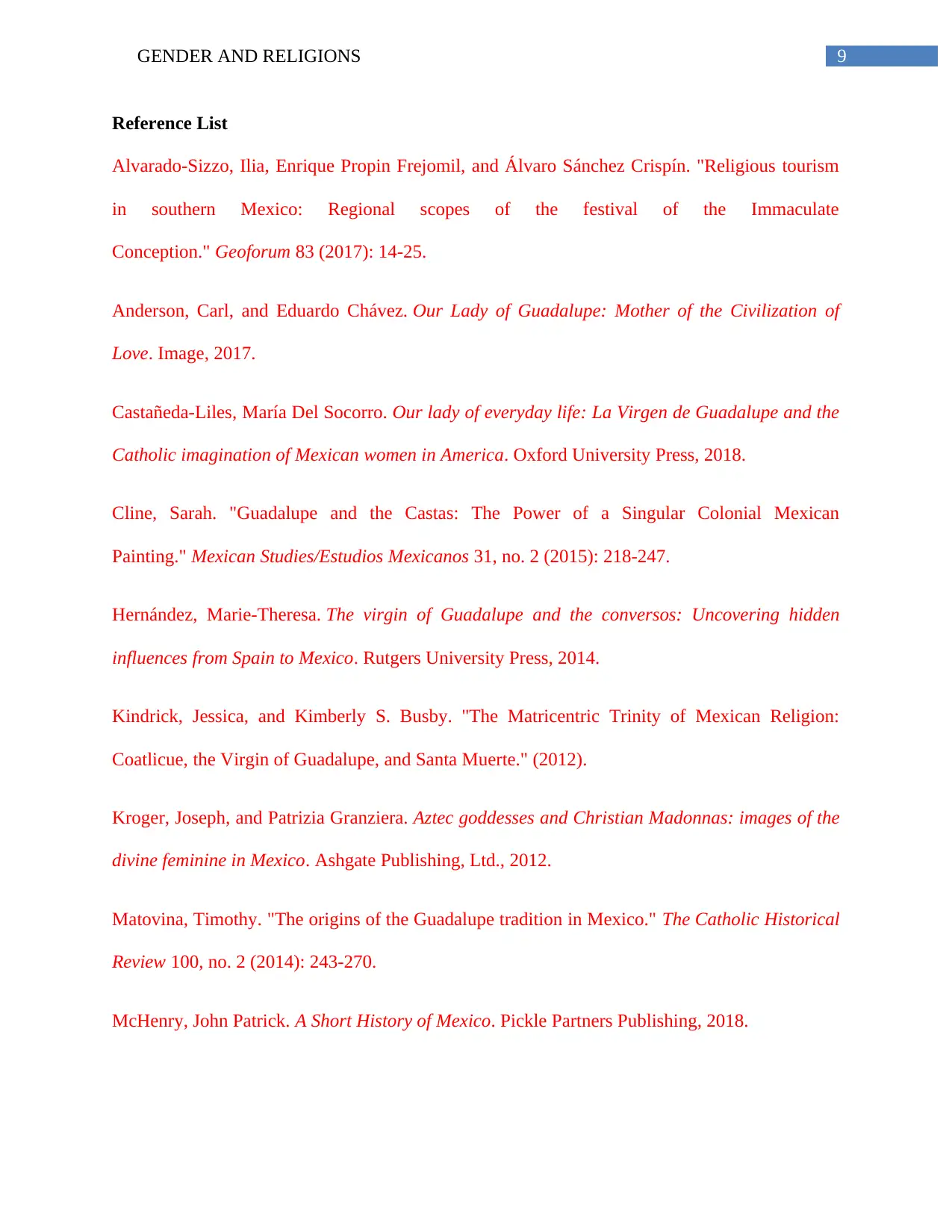
9GENDER AND RELIGIONS
Reference List
Alvarado-Sizzo, Ilia, Enrique Propin Frejomil, and Álvaro Sánchez Crispín. "Religious tourism
in southern Mexico: Regional scopes of the festival of the Immaculate
Conception." Geoforum 83 (2017): 14-25.
Anderson, Carl, and Eduardo Chávez. Our Lady of Guadalupe: Mother of the Civilization of
Love. Image, 2017.
Castañeda-Liles, María Del Socorro. Our lady of everyday life: La Virgen de Guadalupe and the
Catholic imagination of Mexican women in America. Oxford University Press, 2018.
Cline, Sarah. "Guadalupe and the Castas: The Power of a Singular Colonial Mexican
Painting." Mexican Studies/Estudios Mexicanos 31, no. 2 (2015): 218-247.
Hernández, Marie-Theresa. The virgin of Guadalupe and the conversos: Uncovering hidden
influences from Spain to Mexico. Rutgers University Press, 2014.
Kindrick, Jessica, and Kimberly S. Busby. "The Matricentric Trinity of Mexican Religion:
Coatlicue, the Virgin of Guadalupe, and Santa Muerte." (2012).
Kroger, Joseph, and Patrizia Granziera. Aztec goddesses and Christian Madonnas: images of the
divine feminine in Mexico. Ashgate Publishing, Ltd., 2012.
Matovina, Timothy. "The origins of the Guadalupe tradition in Mexico." The Catholic Historical
Review 100, no. 2 (2014): 243-270.
McHenry, John Patrick. A Short History of Mexico. Pickle Partners Publishing, 2018.
Reference List
Alvarado-Sizzo, Ilia, Enrique Propin Frejomil, and Álvaro Sánchez Crispín. "Religious tourism
in southern Mexico: Regional scopes of the festival of the Immaculate
Conception." Geoforum 83 (2017): 14-25.
Anderson, Carl, and Eduardo Chávez. Our Lady of Guadalupe: Mother of the Civilization of
Love. Image, 2017.
Castañeda-Liles, María Del Socorro. Our lady of everyday life: La Virgen de Guadalupe and the
Catholic imagination of Mexican women in America. Oxford University Press, 2018.
Cline, Sarah. "Guadalupe and the Castas: The Power of a Singular Colonial Mexican
Painting." Mexican Studies/Estudios Mexicanos 31, no. 2 (2015): 218-247.
Hernández, Marie-Theresa. The virgin of Guadalupe and the conversos: Uncovering hidden
influences from Spain to Mexico. Rutgers University Press, 2014.
Kindrick, Jessica, and Kimberly S. Busby. "The Matricentric Trinity of Mexican Religion:
Coatlicue, the Virgin of Guadalupe, and Santa Muerte." (2012).
Kroger, Joseph, and Patrizia Granziera. Aztec goddesses and Christian Madonnas: images of the
divine feminine in Mexico. Ashgate Publishing, Ltd., 2012.
Matovina, Timothy. "The origins of the Guadalupe tradition in Mexico." The Catholic Historical
Review 100, no. 2 (2014): 243-270.
McHenry, John Patrick. A Short History of Mexico. Pickle Partners Publishing, 2018.
Paraphrase This Document
Need a fresh take? Get an instant paraphrase of this document with our AI Paraphraser
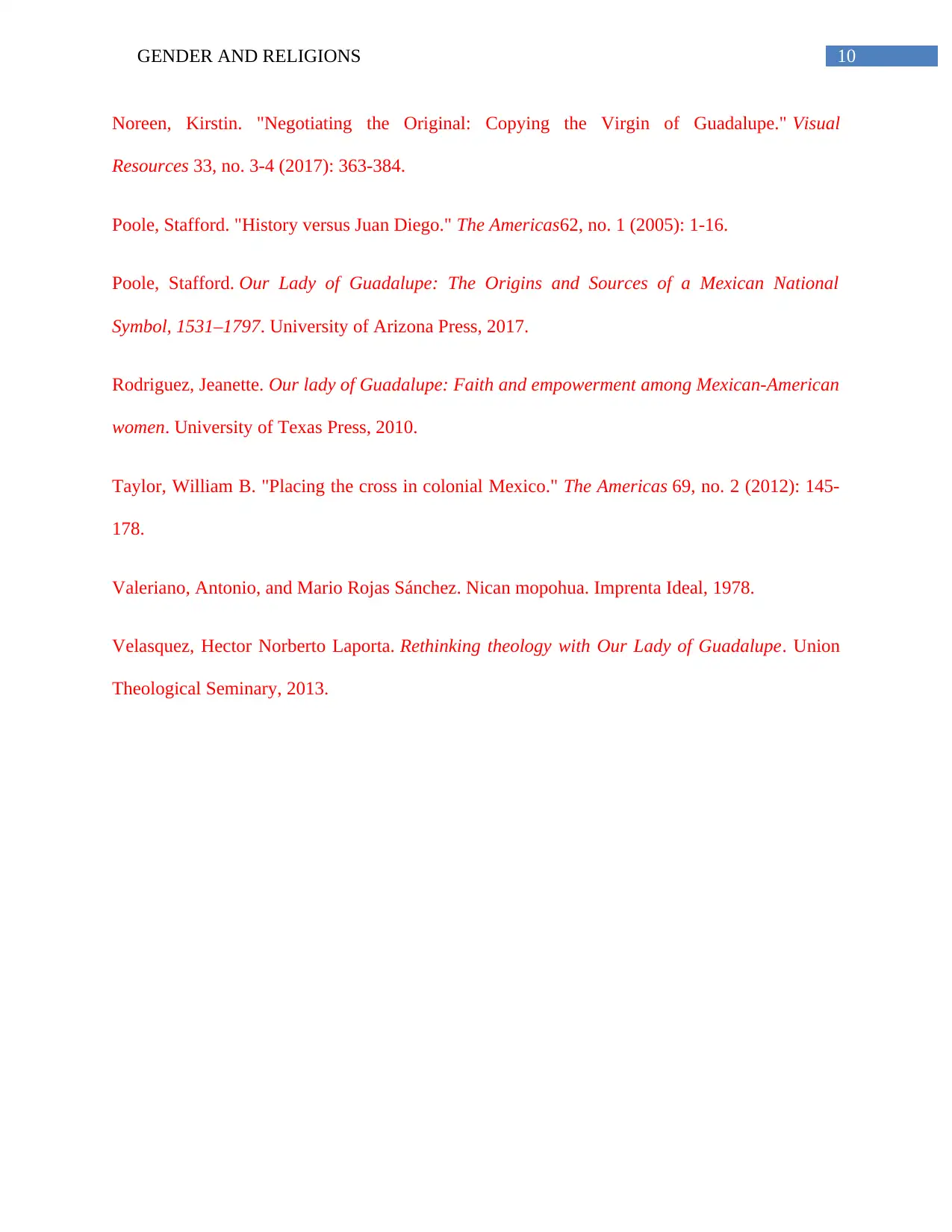
10GENDER AND RELIGIONS
Noreen, Kirstin. "Negotiating the Original: Copying the Virgin of Guadalupe." Visual
Resources 33, no. 3-4 (2017): 363-384.
Poole, Stafford. "History versus Juan Diego." The Americas62, no. 1 (2005): 1-16.
Poole, Stafford. Our Lady of Guadalupe: The Origins and Sources of a Mexican National
Symbol, 1531–1797. University of Arizona Press, 2017.
Rodriguez, Jeanette. Our lady of Guadalupe: Faith and empowerment among Mexican-American
women. University of Texas Press, 2010.
Taylor, William B. "Placing the cross in colonial Mexico." The Americas 69, no. 2 (2012): 145-
178.
Valeriano, Antonio, and Mario Rojas Sánchez. Nican mopohua. Imprenta Ideal, 1978.
Velasquez, Hector Norberto Laporta. Rethinking theology with Our Lady of Guadalupe. Union
Theological Seminary, 2013.
Noreen, Kirstin. "Negotiating the Original: Copying the Virgin of Guadalupe." Visual
Resources 33, no. 3-4 (2017): 363-384.
Poole, Stafford. "History versus Juan Diego." The Americas62, no. 1 (2005): 1-16.
Poole, Stafford. Our Lady of Guadalupe: The Origins and Sources of a Mexican National
Symbol, 1531–1797. University of Arizona Press, 2017.
Rodriguez, Jeanette. Our lady of Guadalupe: Faith and empowerment among Mexican-American
women. University of Texas Press, 2010.
Taylor, William B. "Placing the cross in colonial Mexico." The Americas 69, no. 2 (2012): 145-
178.
Valeriano, Antonio, and Mario Rojas Sánchez. Nican mopohua. Imprenta Ideal, 1978.
Velasquez, Hector Norberto Laporta. Rethinking theology with Our Lady of Guadalupe. Union
Theological Seminary, 2013.
1 out of 11
Your All-in-One AI-Powered Toolkit for Academic Success.
+13062052269
info@desklib.com
Available 24*7 on WhatsApp / Email
![[object Object]](/_next/static/media/star-bottom.7253800d.svg)
Unlock your academic potential
Copyright © 2020–2025 A2Z Services. All Rights Reserved. Developed and managed by ZUCOL.

